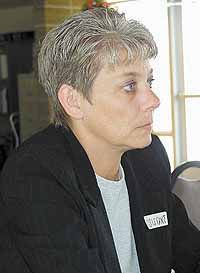| Committee chair Patsy Huff from the public health department oversaw the simulated emergency preparedness scenario. |
Nearly all motorists have become drowsy at one time or another while driving down the road.
Fortunately, in most cases, people manage to ward off the drowsiness and regain control of motor vehicles before the situation turns dangerous.
But when dozing drivers fail to awaken in time, the result is usually an accident, often fatal or with severe injuries.
The United States Highway Traffic Administration estimates that approximately 100,000 annually reported vehicle crashes are a result of drowsiness or driver fatigue.
The figure only represents between 1 percent and 2 percent of all accidents, but driver fatigue is an important factor impacting traffic safety.
Sleepy time accidents account for 4 percent of deaths and about 71,000 injuries per year.
In addition, drowsiness may play a role in accidents attributed to other causes as well.
Many people believe motorists tend to fall asleep at the wheel primarily in the nighttime or early morning hours.
Although drivers frequently doze off during the hours in question, the potentially dangerous situations can happen anytime of the day from a warm summer afternoon to a cold winter morning.
Researchers studying the problem of drowsiness while controlling a vehicle relate the impaired reactions closely to drunk driving.
In fact, some researchers consider the sleepy motorist as a greater threat than the individual who climbs behind the wheel and drives while under the influence of an intoxicant.
In 1997, Stanford University scientists compared reaction times between volunteers who had too much to drink and sleep-deprived individuals.
The researchers concluded that sleepy drivers posed as much of a safety threat and, when even a little alcohol was added to the equation, were even more dangerous than DUI motorists DUI drivers.
The National Sleep Foundation conducted a study in the late 1990s that showed approximately one-third of the adult population has a difficult time staying awake during the day.
Researchers indicate that most people are not getting adequate sleep.
In the study, participants who had a difficult time staying awake noted various kinds of problems.
Twenty-three percent of the participants in the research indicated that sleepiness interfered with social life and 16 percent said it caused problems with families.
Another 12 percent indicated that sleepiness interfered with the ability to drive.
People need varying amounts of sleep. On average, a person needs six to eight hours per night, but the amount of time can vary according to personal circumstances and the activity levels of individuals.
Research studies have shown that the people who are most at risk for being involved in sleep induced-traffic accidents often operate motor vehicles under the following circumstances:
•Driving long distances without breaks.
•Driving through the night, the early afternoon or at other times when they normally asleep.
•Taking medication that increases sleepiness.
•Driving on long, boring rural roads.
•Those that drive long distances frequently, such as business travelers.
•Shift workers. Over 25 million Americans work rotating shifts and they are prone to accidents due to drowsiness, particularly when they are driving home after a night shift.
•Younger drivers. A North Carolina study shows that 55 percent of all fall-asleep crashes involved people 25 or younger and that 78 percent of those drivers were male.
•Commercial drivers. Studies show that sleep and fatigue problems contribute to 30 to 40 percent of all heavy truck accidents.
•Those who have sleep disorders such as insomnia or sleep apnea.
Individual drivers often make excuses for their driving habits rather than face the fact that they are driving too tired, much like those under the influence actually think they are better drivers when they are drunk. Many drivers can’t tell when they are too tired to drive. Some of the signs of dangerous levels of fatigue include the following.
•Eyes won’t focus properly or the driver can’t keep them open.
•The driver nods or can’t keep their head up.
•The driver has disconnected thoughts or daydreams a lot.
•Yawning and rubbing the eyes to keep them focused means more sleep is required.
•Drivers will drift out of their lanes, hit the rumble strips again and again or find themselves tailgating other vehicles a lot.
•Some tired drivers get impatient and irritable.
•Often they can’t remember the last few miles they have driven.
Obviously the best cure for tired driving is rest, little else will cure the problem. However, over time many people have devised supposed ways to stay awake, but few of them work. Open windows, loud radios playing and other devices are only temporary measures.
The best things for a driver to do is to respond to the symptoms of fatigue by stopping and taking a break. If that doesn’t work, drivers should pull off the road to a safe spot and take a short nap for 15 to 45 minutes.
However, the best way to avoid sleepiness is to get a good night’s rest before a drive. If going on long trips, a companion in the vehicle is very helpful, but a sleeping one is no good at all. A good companion can tell when someone is getting sleepy and can help keep the driver awake and focused.
Finally, on long trips, drivers should stop every 100 miles or two hours and take a good break. Caffeine breaks are helpful, but in the long run the caffeine cause can create a drop later, which can promote even more problems.
With the Memorial Day holiday and the first long weekend of the summer looming, there will be a lot of cars on the road. These will be controlled by some people that are sleepy, trying to get to their destinations at the beginning of the weekend and trying to get home at the end.
Paying attention to drowsiness at the wheel could be a matter of life or death for some drivers and their passengers during the upcoming vacation season.

